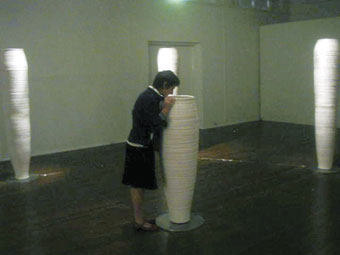Not quite still lives
Keith Gallasch

Dennis Beaubois, Constant (video stills)
Recent video portraiture evokes the stillness of photography, but also includes minimal facial movement over limited duration. The line between stillness and mobility blurs with potent effect. We can still attend to detail in the same way we respond to photographs, reading the idiosyncratic textures of skin, bone structure and the expression that suggests personality. But slight movements on video and subtle expressive changes provoke new musings and re-readings.
When I saw the Asialink-ACMI touring exhibition, I thought I knew but I was wrong, in Singapore as part of MAAP04, I was absorbed by a number of makers’ attention to faces: Destiny Deacon and Virginia Fraser’s volatile child subjects in Forced into Images (2001); Lyndal Jones’ weeping men in He Must Not Cry (2004); David Rosetsky’s morphing subjects in Without You (2003-04); Marcus Lyall’s patient victims of food assault in Slow Service (2003); and the vivid ‘gallery’ of family faces in Ivan Sen’s Blood (2002). These are very different works but the duration of each maker’s gaze allows us the luxury of intense familiarisation and, as well, most of the subjects look back at us in the tradition of much of classic portraiture. The children in Forced into Images are reserved, lively and agitated in turn, but we are with them long enough, even when they are masked, to immerse ourselves in interpretation. Sen’s video is a very different matter, a welter of home-video faces and bodies, intensely re-coloured and overlaid, but with rhythms and repetitions that soon suggest the recurring physiognomies of blood relatives. These videos and others–the gentle turnover of faces with their eyes shut as if sleeping in Merilyn Fairskye’s Eye Contact (2000)–suggest a reinvigoration of portraiture.
Face Value: video portraiture from the Pacific at the Ivan Dougherty Gallery in Sydney takes portraiture face-on. The standout works are in fact the ones that work close to tradition, allowing us duration, attentiveness and the curious pleasure of being eye-to-eye with an absent subject. Lyndal Jones’ He Must not Cry is again on display, if on one screen (as opposed to its multiscreen and more effectively theatrical presence earlier at Artspace) but still drawing painful attention to the effects of weeping (incipient or repressed) on pores, blood vessels and the soft tissues around mouth and eyes, as well as on the whole, wrung-out demeanour as some subjects abandon saving face.
Denis Beaubois’ Constant (2004) offers a familiar idiom, faces morphing one into another, but does it with such precision and sensitivity that the transition from one life-size face to another, even from one race to another, goes unnoticed until it has passed you by, consumately making its point. Constant suggests a shared human face, beyond the distinctions and politics of race, but without ever sacrificing the individual idiosyncracies of its 11 subjects. There are 1,000 transitional frames in the movement from just one face to another in Beaubois’ digital video. Constant’s dialectic is that it is never constant, but always so. John Gillies’ remarkable My Sister’s Roomm (2000) is built from humbler and very different transformations made by the artist holding a video camera in one hand and photographs of his late sister in the other. The photographs pixelate into shimmering yellows and golds and the occasional wavering of the artist’s hand eerily triggers apparent movements in the face. The work becomes a moving meditation on the act of looking at photographs.
James Pinker and Mark McLean’s South video documentation 01/02 (2003) at 60 minutes liesurely, even meditatively, superimposes engaging video portraits of Maori couples, friends and families over the urban landscape of South Auckland as shot from a moving car, while Vernon Ah Kee’s whitefellanormal (2004) at 30 seconds is a stark if poetic face-to-face encounter with dispossession. Christian Thompson appears as famous alter-egos in Gates of Tambo (2005) but the photographic series of the same work is preferable for the intensity of its not always ironic vision. The other works in Face Value are all interesting in themselves, especially in introducing us to New Zealand artists, but curatorially represent a 90s explosion of the concept of portraiture that has little bang left. Face Value is nonetheless a fascinating starting point for reconsideration of a genre.

Panos Couros, Omphalos
photo Panos Couros
Panos Couros, Omphalos
At the nearby Kudos Gallery, Panos Couros’ Omphalos is an engrossing, immaculately crafted installation comprising a circle of seven 2-metre tall, elegant, white ceramic urns with a smaller one at its centre. Sound swirls through the gallery: long, ethereal notes, distant voices, a rush of wind, tumbling water, a soaring chorus. The sound is everywhere, emanating it seems from nowhere, until a voice speaks from the central urn inviting you to approach, to face down into it and ask a question. A surge of sound is followed by an answer (from a selection made by the artist from various divinations). I ask, “When will the drought end?” The oracle replies: “Make a serious commitment to your new project.” I resolve to pass this advice on to the government. A friend is quite taken with his response.
By the entrance there are explanatory notes about the Oracle at Delphi which inspired the work and, intriguingly, a small Byzantine statuette of Mary and the baby Jesus. In a work that combines classic ceramic skills (Neville Assad-Salha) and computer-driven interactivity (Adam Hinshaw, Alex Davies), Couros juxtaposes the era of the oracle with our own information age, raising questions about belief. Belief aside, Omphalos (Greek for navel, and for the oracle at the centre of the world), is an engaging, contemplative multimedia experience.
Face Value: Video portraiture from the Pacific, curators Rilka Oakley, Annabel Pegus; Ivan Dougherty Gallery, Sydney, April 14-May 14 and touring
Panos Couros, Omphalos, Interactive Sound Installation; Kudos Gallery, Paddington, Sydney, April 20-30
RealTime issue #67 June-July 2005 pg. 43






